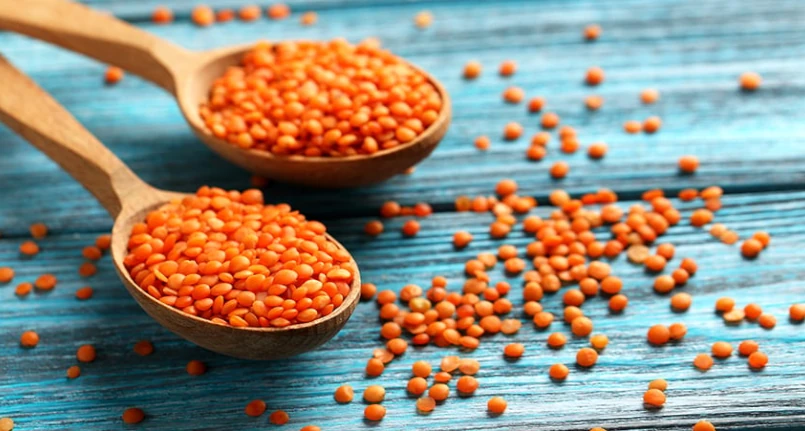What are
Red lentils are the edible seeds produced by the L. culinaris plant (or, L. esculenta). They are not part of a separate botanical typology and owe their reddish color to the deprivation of the outer skin of the seeds – since the pulp naturally has this appearance.
Belonging to the Fabaceae botanical family, lentils fall into the IV fundamental group of foods – as well as: chickpeas , peas , beans, broad beans , soybeans , lupins , grass peas . They supply proteins of medium biological value (more than cereals ), starch , water-soluble vitamins , mineral salts and plenty of dietary fiber .
In the diet, red lentils play a decidedly positive role. Compared to refined cereals and their derivatives, such as white flour pasta , they allow to reduce the total caloric intake, moderating the intake of carbohydrates and increasing proteins, fibers and water, they decrease the digestion speed to the advantage of satiety, they enrich the meal with vitamins and minerals , feed the intestinal bacterial flora and regulate the bowel habit and are considered ideal products in the diet against metabolic pathologies – especially dyslipidemia. Unlike other legumes, however, dried lentils are more digestible and cause less intestinal swelling .
Red lentils are easily available on the market in dehydrated form. To the advantage of other dried legumes , however, these do not require soaking and can be cooked directly, even if always with plenty of water. Among the best-known recipes based on red lentils we find: soups, stews and purees or creams, dry first courses based on semolina / egg pasta seasoned with lentils or – thanks to recent commercial proposals – based on lentil paste , vegetarian meatballs and various ethnic formulas – especially Indian. In the cuisines of the Indian subcontinent, where lentils are a staple food, the red ones are stewed until obtaining a thick mixture to be served with riceor rotis.
Lentils are in fact a plant of Middle Eastern and Asian origin. About 40 cm tall, it has the typical appearance of herbaceous plants and produces seeds similar to “small lenses”, closed inside the pods two at a time. It is an annual crop whose world production comes from Canada, India and Turkey.
Nutritional properties
Red lentils are considered foods with excellent nutritional properties: let’s find out why.
Nutritional properties of red lentils
Red lentils belong to the IV fundamental group of foods.
They constitute an abundant nutritional source of starch and proteins of medium biological value (VB), which supply almost all of the calories contained in them. Fats are marginal, but unsaturated and therefore beneficial to the body.
An excellent level of dietary fiber is appreciated in red lentils. Soluble ones, in particular, are higher in percentage terms compared to lentils with peel, even if the overall level of fibers is still lower.
Red lentils do not contain cholesterol , but phytosterols , substances with a hypocholesterolemic action . The content of lecithins and polyphenolic antioxidants is appreciable . They are also free from lactose , gluten and histamine . On the other hand, phenylalanine is abundant , while purines appear in medium quantities.
Red lentils contain many vitamins, almost all of the water-soluble type of group B. In this case we appreciate the level of: folate, thiamin (vit B1), pantothenic acid (vit B5) and pyridoxine ( vit B6 ). The contribution of certain minerals is excellent, especially iron , phosphorus and zinc .
It should be remembered that legumes are naturally characterized by the presence of various anti-nutritional factors. These are mostly concentrated in the peel and are sensitive to cooking.
Diet
Red lentils have various appreciable dietary functions: let’s see the main ones.
Role of red lentils in the diet
First of all, we can undoubtedly mention the energy function of the starch contained in them. Lentils lend themselves to supporting an active life, but they are not as caloric as cereals and refined derivatives (thanks to the moderate glycemic load ); for this they also have an application in slimming nutritional therapy. They are among the recommended autumn foods with a low glycemic index . We remind you that the calories supplied by dried red lentils, in practice, decrease by about 25%; this is because with cooking the seeds absorb water up to 3 times their weight . Furthermore, we remind those who take this parameter into consideration that these legumes also have a low glycemic index, moderated by the presence of fiber and protein, and insulin . All this makes it an ideal product in food therapy against hyperglycemia or type 2 diabetes mellitus , and against hypertriglyceridemia .
Medium biological value proteins contribute to the intake of essential amino acids , even if with one or two limiting amino acids , which can be easily compensated for by alternating them with cereals.
Fibers, especially soluble ones, are natural prebiotics and modulators of absorption; in synergy with lecithins, phytosterols and antioxidant polyphenols , they hinder the absorption of fats , including cholesterol, a very useful function in therapy against hypercholesterolemia . The intake of lentils is recommended in case of constipation or constipation . They also determine a lower intestinal gas production than that triggered by the presence of insoluble fibers .
They lend themselves to the diet for celiac disease , lactose intolerance and histamine intolerance, but caution is advised in therapy against hyperuricemia and gout , and for phenylketonuria .
Rich in minerals and B vitamins , they support various enzymatic functions essential to cellular processes.
Kitchen
Organoleptic characteristics of red lentils
The flavor of lentils is characteristic, pleasantly “earthy”, with a slight sweetish taste and a tendency to lightly lapping.
On the market they can be found mainly dried or cooked and in jars or briks – in brine . Unlike most legumes, even dried lentils do not require pre-soaking.
How to cook lentils
They are consumed in many ways: sprouted and eaten raw, boiled, stewed, sautéed , fried and baked. From the grinding of the dry and hulled seeds, lentil flour is obtained , used for many different purposes, such as the very recent use in the production of pasta.
Red lentil pasta has the advantage of preserving the purpose of wheat pasta , while offering several nutritional benefits. It is considered as a dietetic food and, by alternating or associating it with ingredients containing cereals and other grains, it constitutes an essential element in the nutritional regimen of vegans , who usually struggle to reach the necessary protein intake.
The most common method of preparing lentils is in a pan, both by boiling and stewing. Whole seeds with peel usually require a maximum cooking time of 40′. The smaller, peeled and broken varieties, such as the red lentil, are ready in just 10′ – after which they tend to break down into a thick puree.
They are widely consumed in the packaging of first courses with a spoon, such as purées and velvety soups, stews and soups. The red ones, however, lend themselves more to quick recipes, or should be added no later than 15′ from the end of cooking.
The cold use of boiled seeds for summer salads is also frequent, even if lentils in jars with peel are generally used for this purpose.
With cooked red lentils it is also possible to make small meatballs to be browned in the oven or fried.
Lentil flour can be used in the cut (no more than 10%) of wheat-based flour for leavened bread making , increasing its nutritional value and taste. On its own, however, it can be used to make flat bread to be cooked in a pan.




